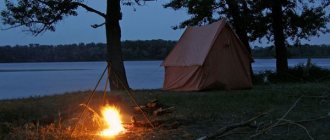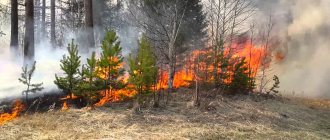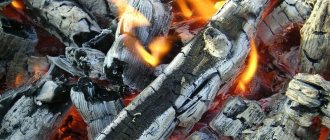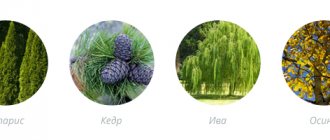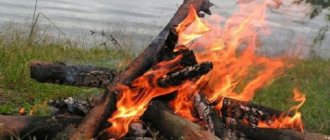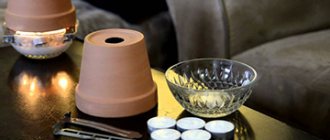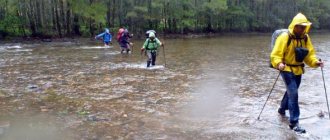Nodya is a taiga long-burning, or rather smoldering, fire, which is most often used for spending the night in the forest without a sleeping bag or tent in the winter season.
The main feature of Nodya is long burning. This is the longest-burning fire that does not require frequent adding of firewood, and if properly organized, it burns all night and allows a person to spend the night in the forest at low temperatures without unnecessary hassle. There are known cases of successful safe overnight stays with a node in the forest without sleeping equipment at minus 20°C - minus 30°C.
Due to the complexity of preparation, this fire is used mainly at low temperatures and, as a rule, in bivouacs intended for several overnight stays.
Classic node made of two logs held by stakes
The classic node consists of two even, fairly thick logs, one of which lies on the other. Due to this, such a node is also called vertical. In this fire, the fire burns with a weak flame between the logs along their entire length, providing warmth to the person lying opposite.
The incorrect name for a fire is nadya. This mistake is made simply out of ignorance. The fire is often also called “Siberian Nodya” and “taiga Nodya”, but these terms mean the same thing.
There are several options for making a node, differing in the complexity of the design, the duration of combustion, the need for support during the night and the amount of heat generated. Under different conditions, one design or another is more preferable, and sometimes the only acceptable one. At the same time, in order for the fire to flare up and not go out while a person sleeps (which is fraught with freezing), it is necessary to comply with the requirements for the preparation of firewood, installation of the fire and its operation.
Nodi options
There are at least three main options for constructing a node.
The “classic” (vertical) node consists of two logs, one of which lies on the other. This option is quite capricious, produces relatively little heat, but burns longer than other types of fires. It can be recommended when there is a lack of fuel or in cases where disproportionately more effort and time will be spent on harvesting excess logs compared to the benefits received from the fire.
In the photo there is such a node:

The “lazy” node is made of three logs, two of which lie on the ground close to each other, and the third is located parallel to the first two in the groove formed between them. This option is so unpretentious that it will continue to burn even if a snowdrift falls on it from a spruce branch. However, to fold it, you need to select the right logs and place them relative to each other.
The video shows how to make a lazy node:
Unlike the classic version, a lazy node lights up more easily, burns brighter and releases more heat, but also burns out faster. For an overnight stay with this option, it may be recommended to prepare a spare log in case the fire burns out prematurely. A lazy node is used in cases where there are no problems with harvesting additional logs - in the taiga, winter deciduous forest, near ravine forests in the steppe. A detailed description of this type of fire will be given below.
A nodya from one log is a log that is not completely split in two, inside of which a fire burns. Like the two-log node, the single-log node is sometimes called a vertical node because the two burning surfaces are located one above the other. But unlike the classic version, a node from one log can burn even in a vertical position. This version of the node enters operating mode faster than others and burns in approximately the same way as the “classic” one.
Such a node, unlike two- and three-log ones, is intended to heat only one person lying opposite the fire. It burns faster compared to other options and requires additional manipulations for its manufacture. This fire can be recommended if there is a lack of logs and the possibility of splitting these logs into two halves.
Construction of a fire from three logs
A three-log node is constructed from three logs. The design scheme is quite simple - two logs are located on the ground, pressed tightly against each other, and a third one lies on top of them.
It is believed that this option is more productive and even if a snowdrift falls on it, the burning will not stop. But in order to do it correctly, it is necessary to choose the appropriate material and evenly lay the wood itself.
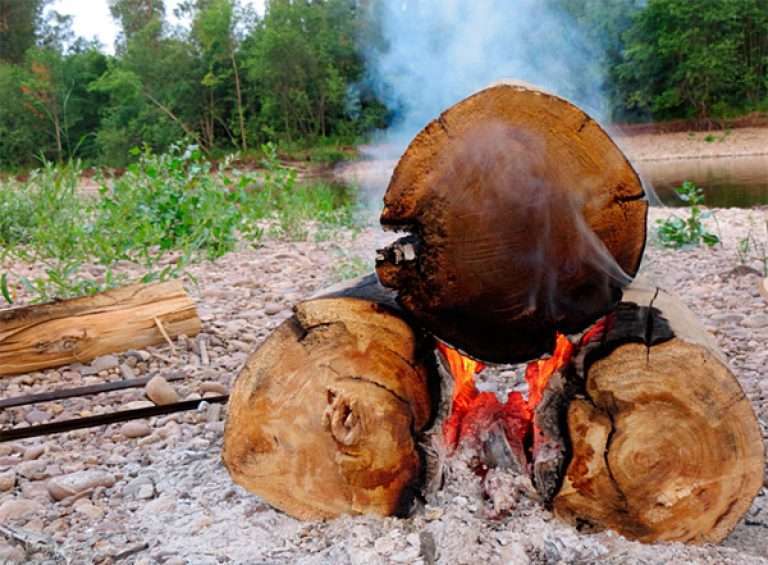
To maintain stable combustion, many recommend systematically turning a log with a burnt-out center. You can also trim those edges that the fire has not yet touched; these actions will help achieve a uniform fit.
If you need to turn the wood, you can use two ordinary axes, which you will need to stick into the ends of the log. In order for the combustion process to be as uniform as possible, you must achieve the tightest possible contact between the wood.
- much easier to light;
- combustion is accompanied by bright light;
- During the combustion process, a lot of heat is released.
But the main disadvantage is that it burns out quite quickly. Therefore, for spending the night with this type of fire, it is recommended to prepare spare wood, which will be needed if it burns out prematurely.
Expert opinion
Smirnov Alexander Stanislavovich
Wilderness survival instructor. More than 15 years of teaching experience
We can also say that this option is appropriate to do if there are no difficulties in preparing additional materials, or more precisely, if you are in the taiga or forest.
In conclusion, it should be said that the Nodya taiga fire is rightfully considered the best option to warm up on a cold winter night.
What other simple fires do you know? Share your knowledge in the comments! And also watch a video on how to properly build a fire from two logs.

Nodya is exactly the fire with which our (and not only) ancestors, who lived throughout the taiga region of Eurasia - from Scandinavia to the Far East, warmed themselves in the cold taiga forests. Almost all the languages of the northern peoples have a word for this particular fire - nodya.
In general, the term Nodya comes from the Finno-Ugric languages, which in translation simply means “bonfire”. There are several options for knots, the main ones are knots made from one log and from two.
In this report, my friend Max and I will show you our experimental node from one log, which we had the pleasure of cutting and then kindling on the night of November 1-2, 2014. To be honest, for Season 2 I still couldn’t get out into the winter forest with an overnight stay to make a report on the node, somehow it didn’t work out, but now my partner and I managed to do it.
This is interesting: Map of publicly accessible and assigned hunting grounds of the Rostov region
Looking ahead, having thoroughly analyzed our result, I want to say that we still succeeded in the knot, and the desired effect was achieved from it, but still this skill still requires numerous repetitions and development of dexterity. You need to learn to take into account many factors, such as lighting the node, harvesting wood, the optimal location from the place of overnight stay, etc.
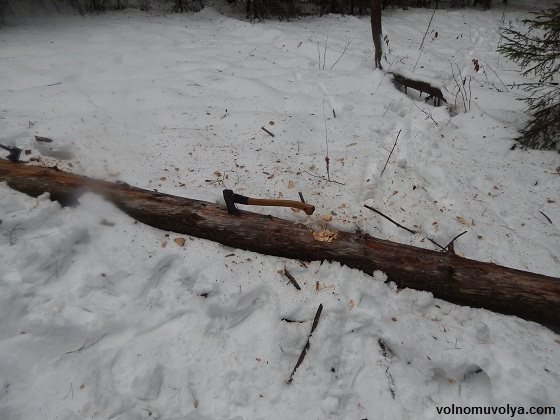
Not having a saw with us, we chopped it with a taiga ax, this is a very dubious pleasure, because cutting dry wood is problematic, but nothing can be done.
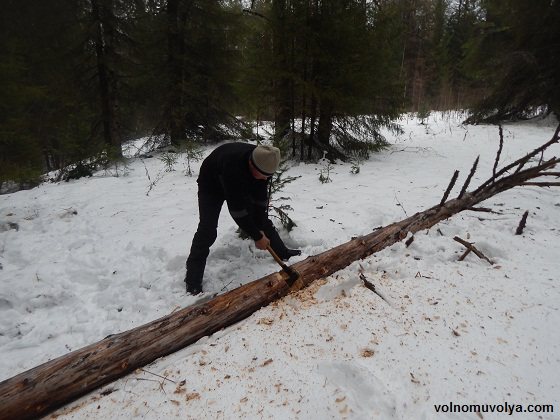
In total, we ended up with 3 places to cut down: cutting down the tree itself and cutting down blanks for the node. One piece was 2-2.5 m long - this was the lower part of the node.
The other (upper) was longer - about 3 m. Next, in order for the node to engage in fire well, a small groove must be cut on one side of each log; it is better to make not just a straight bevel, but a groove, just like cutting a groove on frame the hut so that an air gap is formed, and the node is well occupied by the coals.
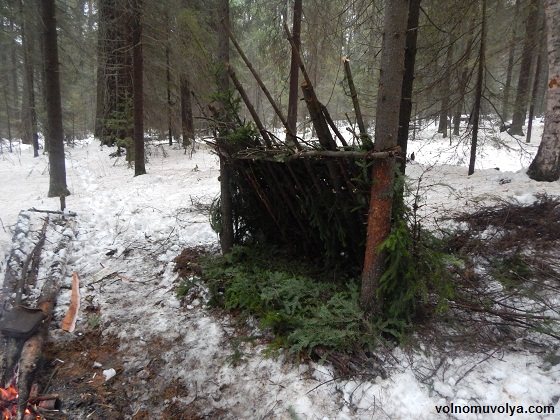
Also a necessary attribute of spending the night at a node is an equipped overnight place. A screen is built on the windy side; it will protect you from the cold wind and somehow reflect infrared radiation from the node - thereby further enhancing the effect of the fire.
The flooring needs to be built at some distance from the ground, and the lying area must be properly isolated. The hut-screen in the photo was built by me earlier, we just updated the spruce branches on it so that the old one would not catch fire.

Nodya was collected and was waiting in the wings for us to start kindling her. Next to her we burned a regular fire, on which we cooked food and dried our wet socks and boots.
We started lighting the fire at 16:30, when it was already getting dark. It was an experimental node, we didn’t plan to sleep next to it all night, we had a tent.
Actually, the night of lighting the node was already the second night in the forest, because in a short daylight it is impossible to do everything, come to the place and set up a camp.
Having had a hearty dinner of camp gruel, Max was drawn to the side, and at 21:00 he went to the tent. I was left alone, alone with my desired node.
I took my sleeping bag and lay down under the screen. I didn’t want to sleep, so I just lay there and tested our brainchild.
The temperature outside was +3 degrees, i.e. no minuses or severe frosts.
Expert opinion
Smirnov Alexander Stanislavovich
Wilderness survival instructor. More than 15 years of teaching experience
But for the first time, we did not take risks and go straight into the wilderness, but decided to try it at a low temperature. Lying in a sleeping bag without a foot is cold, but with a foot it’s quite comfortable.
However, the node should not burn with flame, it should roam, i.e. there should be just coals in its mouth.
Some experienced taiga dwellers recommend spending the night near the node at a distance of about 50 cm; provided there is no flame, this becomes a fairly comfortable activity, but if it flares up, then it is impossible and impossible to lie next to it.
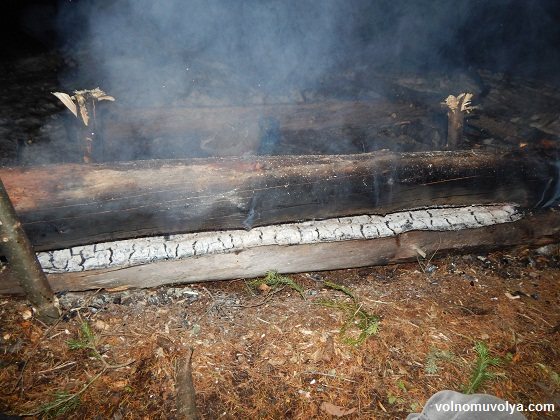
In the seventh hour of its burning, at 23:40-50, the node suddenly flared up. I tried to knock down the flames with sticks and snow, hit the top log against the bottom one, and then eventually spat and threw the log to the ground.
I still didn’t plan to sleep there all night, so after going through the experimental period, feeling the warmth of Noya, I decided to stop the experiment and go to sleep in a tent. It was impossible to be near the burning node.
Not to say that our node was made according to all the requirements and guests of taiga life, however, the desired effect, in the form of a 6-hour stable combustion, was achieved. In principle, 6 hours of sleep is enough, but 8-10 is preferable, given the general fatigue on hikes.
With some experience and skill, these 8-10 hours can be achieved quite easily. And also, if the problem of fire is solved, then in a node of this diameter it is possible to achieve results of more than 10 hours of combustion.
However, it is problematic for one person to pull such logs; single taiga dwellers take a smaller diameter.
The essence of the node is that a person can have a good night's sleep in the conditions of a winter forest and in the morning have the strength for further work (hunting or something else). When you sleep under an ordinary fire (any other) and receive warmth from the flames, then from the moment the flames disappear, as the wood burns out, you will become cold, and you will be forced to wake up and adjust the fire, and as a result you will not sleep well.
Nodya is designed for long, even burning (smoldering) without flames, in which you can sleep without waking up all night.
Good materials for nodes in the taiga forest are pine, larch and cedar. Spruce shoots, fir burns quickly, birch is hard to find dry and it also shoots, other trees are rare.
The optimal length of the node is 2 meters; it will cover the entire length of your bed with a margin. For ignition, it is better to use coals and dry wood chips, as well as birch bark.
You will have to work a lot with your lungs and fan the coals in the crevice of the node.
In my next trips, I will try to take into account previous mistakes and make a better node, plus use some bells and whistles. The experiment will continue until the skill is fully consolidated.
Author: Ilya Kultaev · Published 04/22/2020 · Updated 04/26/2020
Expert opinion
Smirnov Alexander Stanislavovich
Wilderness survival instructor. More than 15 years of teaching experience
Nodya is a long-burning fire, used mainly in the winter or cold seasons, so that you can sit or sleep nearby for a long time, without the need to add firewood.
One day, on a summer weekend, a couple of instructors had nothing to do, and they went to the nearest forests near Moscow to reconnoiter the area for the possibility of holding classes for the next water tourism school in the fall.
In the good old days, the instructors also went to the forest in advance to find a dry tree suitable for training and plan the route so as to be near this tree at the right time.
Now you also need to go into the forest for reconnaissance, but the situation has changed, and you need to look for forests miraculously preserved in the Moscow region, between the fences of garden plots, cottage villages and dead wood.
This time we didn’t find a place suitable for school activities, but we came across a clearing between numerous clearings and construction sites, which already had firewood, which could be used to film a video about the fire of the node.
The classic Nodya differs from the taiga fire in that the fire is made of two logs placed one on top of the other. With this arrangement of logs, the combustion process (or rather, even smoldering) proceeds evenly and slowly, and the heat from the fire spreads horizontally along the ground.
Thus, the fire turns out to last for a long time; you can comfortably sit or lie near it for a long time without the need to constantly add firewood.
And if you spend the night with a node in the morning, there is a high probability of preparing breakfast with its remains.
However, like any process, in addition to pros, there are also cons. To prepare a node, you need quite large logs and time, plus a certain amount of knowledge and skill.
This is where we hope our simple video will help.
“Classic” node made of two logs
For a classic node, two logs are prepared. Their thickness should be at least 25 cm: in this case, the burning of the node is enough for a good night’s sleep.
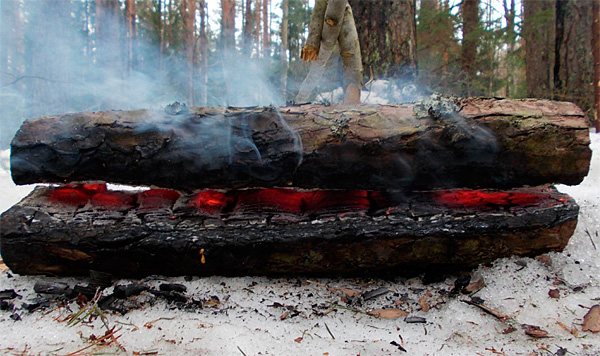
The combustion center is located at the junction of the logs and the fire burns until the top log is completely burned out.
On prepared logs, knots and bark are removed in places where the logs will face each other.
Next, you need to place one log above the other. This can be done in several ways:
- Hanging on "fishing rods". In this case, longitudinal slits are made in the upper log on both sides with an ax, into which two wooden wedges are driven, in the upper part of which recesses are made for hooking onto fishing rods. Two fishing rods are made from elastic branches, the thick ends of which are attached in any convenient way to the surface of the ground, the middle of the fishing rods is placed on dead wood, and the upper log is hung from the thin ends by wedges. The ends of the fishing rods should have knots or indentations cut with an ax so that the stakes along with the logs do not slide down the fishing rods. However, it should be remembered that the upper deck should not be raised above the lower one. On the contrary, it should press tightly against the bottom log even when it is almost completely burned out and loses most of its mass. If this requirement is not met, the distance between the logs will eventually become too large, the coals of one log will no longer sufficiently heat the coals of the other and combustion will stop. The fishing rods in this option only keep the top deck from rolling to the ground. The picture below shows a diagram of the device of such a node:
- Driving in four stakes. Four long, dry sticks driven into the ground on both sides of the node will keep the top log from rolling to the ground. This option is simpler than the first and allows two vacationers to camp for the night on both sides of the fire at the same time. Using a support. To implement this option, the bottom log is placed in a small recess, supported on both sides by logs or stones, rests on its own unbroken knots, or is installed in a stationary position in any other way. A longitudinal slit is made in the middle of the top deck with an axe. A wedge is driven into the gap. The wedge is supported by a spear placed with its base on the ground. This option is simpler than the previous one and can be implemented in conditions where it is not possible to drive stakes into the ground, for example, when installing a node on icy ground.
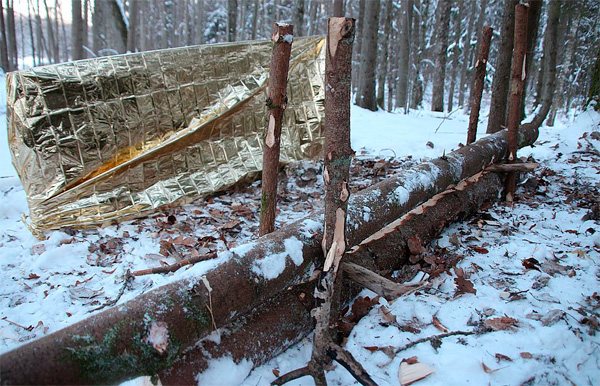
Knot stakes can be made from any suitable materials - the main thing is that they fulfill their purpose. - Installation of logs with edges facing each other. To do this, the lower log is fixed in the previously described way and notches are made on each log so that in the working position (when the logs lie with the logs facing each other) the upper log does not roll off the lower one. This method is good if you have an ax, since it will be problematic to make cuts on thick trunks with other tools, for example, a knife.
You can light a knot of two logs in at least three ways:
- Kindling is placed on the bottom log and set on fire. Brushwood is added to the kindling to form coals. To ensure the flow of oxygen, two small sticks with a diameter of up to 5 cm are placed on both sides perpendicular to the lower log, after which a second log is placed on top. The sticks are removed when the node enters operating mode and begins to burn evenly along its entire length. Despite its simplicity, this method is quite capricious and may require several attempts for the fire to start burning on its own. To make the task of igniting a node easier, it is better to resort to the trick described in the second method.
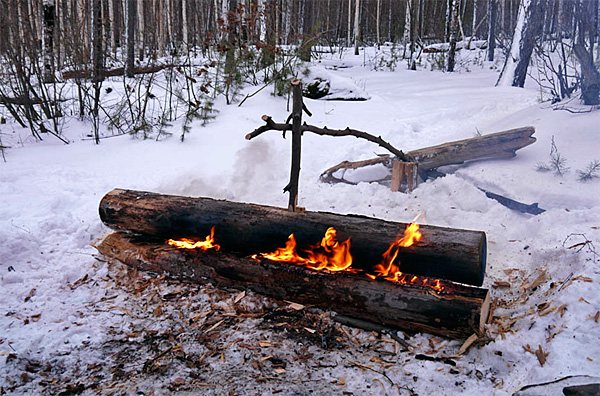
The main requirement when constructing a node is to ignite it along the entire length of the logs, which will ensure uniform burning of the fire. - As in the first method, in addition to kindling, two thin sticks are placed between the upper and lower logs. Close to the bottom deck and parallel to it, another log (possibly thin) is installed on supports - it turns out to be a kind of node of three logs. Kindling is placed in the recess between the two lower logs and set on fire. Thicker brushwood is added to the burning kindling until coals form and three logs burn independently and steadily. When a sufficient amount of coal is formed between the upper and lower logs for stable burning of the log, the auxiliary deck is removed.
- Two logs are laid on the ground close to one another. Kindling is placed on their areas, cleared of bark and slightly turned towards each other, so that separate fires are formed along the logs, arranged like huts, located at a short distance from each other. The fires are lit and maintained until coals form on the logs themselves. After this, the logs are installed in the working position, and two sticks are inserted between them on both sides to supply oxygen to the combustion area. When the node enters the mode and burns evenly over the entire working area, the sticks are removed.
When a log burns, a situation is possible when part of the upper log moves away from the lower one due to the unburned areas along the edges. This leads to a decrease in the efficiency of the fire due to a decrease in the burning area, because in this case the node will burn only in one or two areas, and the rest of it will “stand idle” without use. The photo below shows a view of a node in which the flame is distributed evenly along the entire length of the logs:

To get rid of this problem, the top log is shifted 15–20 cm along the bottom one. In this case, the bulging areas fall into the burnt-out depressions - the distance between the smoldering coals is reduced, and the node again enters operating mode.
Bonfire "Nodya"
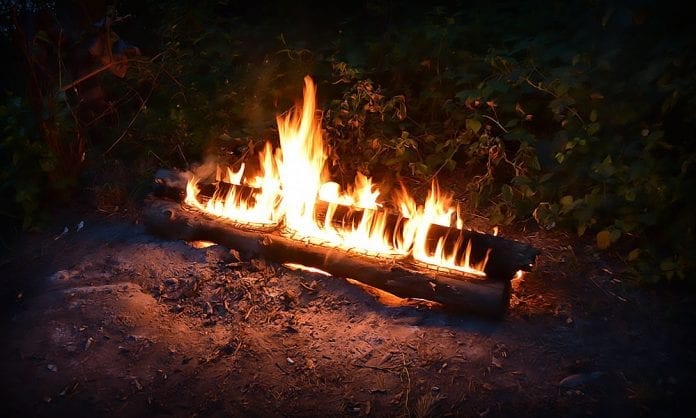
Nodya is a type of fire for the toughest extreme winter overnight stay in the taiga in the bitter cold under the open sky. To organize such an overnight stay requires a lot of effort. But if there is a question of life and death, you need to know how to do it correctly.
Among huntsmen, hunters, and geologists, for whom, due to the specific nature of their service, comfortable sleep is important to restore strength and performance, Nodya is considered the best winter fire, for the reason that it burns very economically, evenly in terms of heat transfer and, provided it is properly constructed, not requires supervision throughout the long winter night.
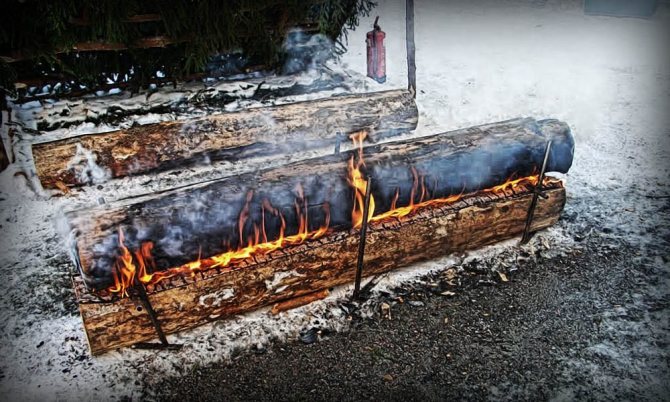
Building such a fire requires a certain amount of experience, which is still recommended to be acquired in the warm season, so that something unexpected doesn’t happen later...
Construction and arrangement of Nodi
To equip the node, thick logs 2-3 meters long from dead coniferous wood are used. They are stacked horizontally on top of each other with a special self-regulating gap between them, which ensures even combustion. A real node is made from only two logs. Sometimes a node is confused with the so-called hunting fire “stack”, which is made on approximately the same principle as a node , but from three, six or even fifteen trunks, depending on their thickness.
A hunting fire, unlike a nodya , is unstable and therefore requires constant supervision by a fireman. But we won’t confuse things, and we’ll tell you about the original node made of two logs.
Important points when constructing a node:
- Firstly, it is important to take into account that it will take 1-2 hours to build a camp with a node - this is not an easy task. Therefore, you should start by correctly assessing the available daylight time.
- Secondly, you will need a high-quality hatchet or bow saw.
- And the third significant point is the competent choice of material for the node .
The best option is dead pine. You can also use poplar or aspen. Spruce sparks and shoots a lot, but larch is too hard and difficult to light. You need to find a tree that is dry, relatively smooth, with a small number of ingrown knots, not hollow or resinous. It should stand on the root, be free of bark and most of the skeletal branches, and have an intact tip. If the tip is broken, the wood inside is probably damp or even rotten due to rainwater getting inside.
Where to begin?
So, a suitable tree has been found. The camp site is marked. First, we light a regular fire for cooking. Then the coals from this fire will help us ignite the node .
While the pot is boiling, cut down the selected tree. Let us remind you that the first notch (cut) is made 1/3 of the depth on the side where the tree will fall. The second notch, slightly less deep, is made on the opposite side from the first notch, 6-8 cm higher. When felling a tree, do not forget about safety precautions. You need to cut down a tree with a long stick, otherwise there is a non-zero risk of hitting the butt on vulnerable parts of the body.
Then, from the side of the butt part, we cut out three equal parts with a length slightly larger than our height. Two parts will be working, and the third will be a spare part, in case the top log needs to be replaced at night. In order for the log to last for the entire long winter night (12-14 hours) without changing the top log, the thickness of the logs must be at least 40 cm in diameter. Now both logs need to be hewn on one side by 2-3 cm. Small fires will then be placed on the flat of the lower log.
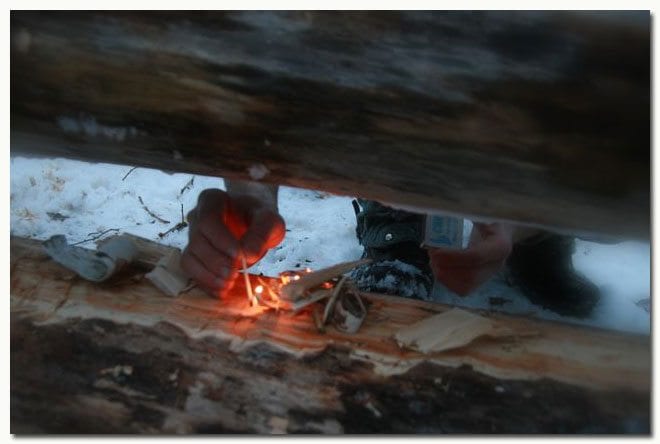
Now everything is ready to lay the structure. Another important point is that the node should be positioned along the predominant wind direction. Because the bed(s) will be located along the node . If the snow is deep - 1.5-2 meters, the flooring is done first. Otherwise, during the combustion process, the node will unevenly sink into the snow and may fall apart. To do this, several damp poles are placed across the future node the node itself is placed on top .
We place the bottom log on the prepared base with the flat side facing up, of course. We fix it with stakes or stones along the edges. We place the second log on top of it with the flat side down, of course. At a distance of 30-40 cm from the edges, we lay transverse logs or wedges with a diameter of about 8-10 centimeters between the logs. This results in a fixed gap.
The entire structure must be secured: someone hangs the top log on special tagankas, someone fixes it with additional pegs, someone ties the entire structure to standing trees - improvisation taking into account external circumstances is not prohibited here.
In the gap that we have between the upper and lower logs, we light 3-4 small flames along the gap of the fire, using any dry combustible material: aspen chips, for example, moss, birch bark, etc.
There is one more trick. At a distance of approximately 8-10 cm from the top of the lower log, along one of the sides, or possibly along both, a long, thin pole is stuffed. It turns out something like a trench into which you can pour hot coals from our first fire, which has burned out by this moment. This will help to quickly ignite the inner surfaces of the node .
The main problem at this stage is to distribute the fire evenly throughout the entire gap, gradually expanding the burning zone of the initial fires. As soon as the logs of the node are engulfed in flames, you can consider the job done and begin constructing the beds and screens.
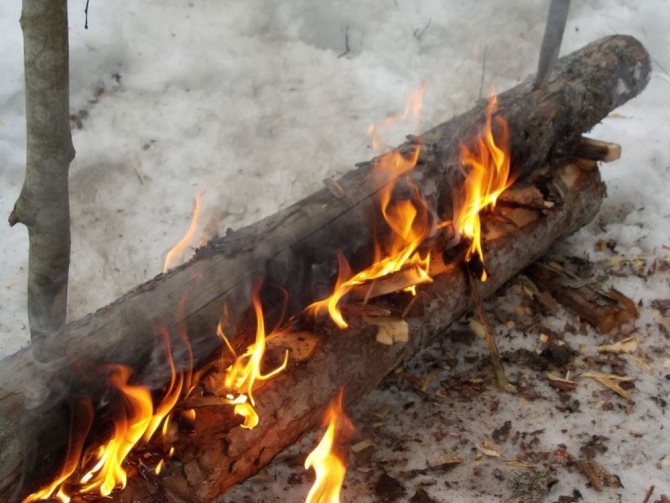
The level of heat transfer from the node is regulated by the thickness of the gap. The optimal thickness is 5-6 cm. But during the combustion process, the structure will live its own life, and the gap profile will constantly change. First, the upper ridge will rest on logs placed along the edges. When they burn out, a sufficient amount of coals have already formed in the internal gap, on which the top log settles. From this moment on, the node becomes self-regulating and does not require further supervision.
However, for this wonderful moment to come, experience in maintaining a uniform flame along the entire length of the node . If you do not have such experience, or you are not sure of the result, it is better to prepare a safety bundle of firewood for the whole night, in case the node becomes capricious and does not take place.
Lazy node made of three logs
A lazy log requires logs of different thicknesses, although it can be made with logs of the same diameter.
If one person plans to spend the night near the node, the thinnest log is placed in front, a log of medium thickness is placed behind it, and a log with the largest diameter is placed on top. Due to this arrangement of logs, the fire will warm the person lying next to it more strongly, since radiation from the rear burning log will be added to the infrared radiation of the front and top burning logs.
For example, the photo below shows an incorrect structure of a node made of three logs:
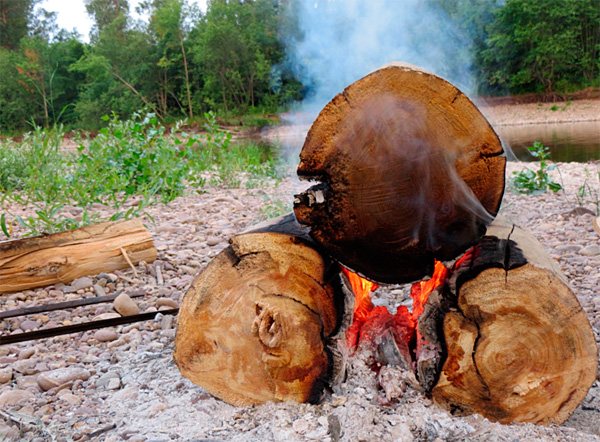
The correct node of this type is either made from logs of different diameters, or the tilt of the fire is ensured with the help of special poles.
It is important to understand that if the lower decks have the same diameter, the maximum radiation will be directed diagonally upward and may not reach a person lying below a certain level. Although in this case, a fire of 3 logs will warm the vacationer, but worse, and some of the heat will be wasted.
In order for the fire to burn for a long time, the top log must be of sufficient thickness, since it will burn first. For a full overnight stay, it must be at least 30 cm. If it is not possible to prepare a log of such thickness, then take two or more thin logs (15-30 cm). It is important to understand that in order to prolong the burning of such a fire, thin prepared logs will need to be added as the previous ones burn out, that is, to maintain the fire, you will have to wake up several times.
The bark should be removed from both lower logs in the places where they will burn and cuts should be made. This will help ignite the node faster and easier. It is better not to do this with the top log: it will burn strongly and quickly anyway.
On the lower logs, as in the classic version of the node, kindling and two sticks providing oxygen to the coals are placed. The kindling is lit, and when the first coals appear, the third log is placed on top.

Ignition in one place is allowed only when it is then planned to distribute the flame along the entire length of the node.
After the knot flares up, the auxiliary sticks are removed from under the top log.
This type of node can be used for cooking. To do this, the top log is slightly shifted along the groove, freeing up space on which you can, for example, install a pot. This cannot be done with a classic node.
But this option also has a significant drawback: a “lazy” node leaves the fireplace on the ground, and when used in the snow, it strongly heats it underneath. To get around this unpleasant moment, you need to use a flooring of thick branches, which will be discussed below.
Types of fire - Nodya
Many people, due to duty or other circumstances, often have to be in nature, spending the night in hunting huts, huts, tents and around open-air fires. These are, first of all, hunters, rangers, game wardens, foresters, geologists... They practically need to know a lot and be able to organize their simple life in the best possible way under the current circumstances. Normal rest in “comfortable” conditions allows you to quickly restore your performance, protect yourself from hypothermia and many colds.
Spending the night in the forest in the open air in winter, possibly in severe frosts (down to -40 degrees and below), without exaggeration, can be classified as extreme circumstances. If such a situation cannot be ruled out, then you need to prepare for it adequately and organize your overnight stay as comfortably as possible. Of course, this requires a good ax; a bow saw can make preparation easier (although the latter is used extremely rarely). For overnight stays, a number of fires have been invented, differing from each other in design and in their properties - brightness, intensity and consistency of heat transfer, efficiency, requirements for constant care, and so on. Nodya is considered the best winter fire, as the only fire characterized by the greatest efficiency, uniform moderate burning and the ability to self-regulate. A fire under this name is described in many sources, but, unfortunately, superficially or incorrectly. Only two articles come to mind that do not have major errors. This is “Nodya of Ket hunters”, published in the magazine “Hunting and Hunting Management” forty years ago, and V.A. Moskov in the collection “Organization and Technology of Hunting” (1977). My own long-term hunting and field practice reminded me of many of my own mistakes due to incorrect recommendations, but at the same time it made it possible to clarify many little-known subtleties. For the first time I heard about the original, and the only correct, structure of the node from my father, an experienced game manager and teacher at the Faculty of Game Management of the Irkutsk Agricultural Institute, Vitaly Ksenofontovich Zharov. This fire is used by many hunters in the Urals and Western Siberia. To the east of these regions, the knot is used very rarely, since many hunters are not familiar with its design and do not know the requirements for the material and correct design. This bonfire, of course, requires intensive propaganda and widest dissemination.
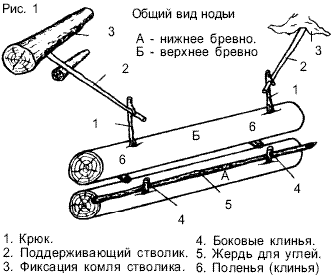
In the design of an authentic node there are only two logs, which are laid horizontally one above the other, the fire is kindled between them and gives uniform and long-lasting heat due to slow burning.
In a number of recommendations, the nodya is depicted as consisting of three logs (two on the ground, one above them); it is essentially a hunting fire in a “stack”, which is often made of five or more logs (the first row of three logs on the ground, the second row of two above them , the third - from one at the very top). This fire has nothing to do with the Nodier, since it excludes the main properties of a real Nodier - the uniformity and duration of combustion, efficiency and self-regulation of the flame.
In other recommendations, the node is depicted as consisting of two logs, but the top one is supported by two pairs of stakes driven into the ground. I note that Nodya is the best winter fire, and in winter it is not possible to drive stakes into frozen ground; even in summer, with rocky soil, this is very difficult. With this design, the support stakes quickly burn out, and the property of self-regulation of the flame is generally lost. We have to replace them, and more than once - there’s no time for sleep.
In the original node, a simple technique is used to support the upper log, with the help of which self-regulation of the combustion process is achieved. Two hooks are driven into it from above and along the edges (one in the middle is possible). The length of the hooks is at least 60 cm (Fig. 1). This operation is performed as follows: from the opposite end from the fork, the hook is cut onto a wedge, an ax is used to make a gap in the upper log, into which the wedge-shaped part is driven into the hook with gentle blows. Under each hook, a raw and flexible stem of a birch tree (aspen, rowan, willow, or, in extreme cases, larch, pine) is brought under the apical part, its butt part is firmly fixed in the roots of the tree, bushes, stones or pressed down with a block (pole, stone), similar to the Taganka device when cooking food by the fire. The length of the stem is from 3 to 4 meters, the diameter in the butt part is 5-6 cm, in the apical part - about 2 cm (as thick as a finger).
The main role of the Taganka is to maintain the balance of the upper part, prevent it from rolling off and provide a self-regulating combustion mode. The length and thickness of the hooks and tagankas do not allow them to burn at the top, and the thickness of the latter allows them to sag as the top log burns and reduces weight. The nodya will burn even when the upper part thins to the slab. Instead of tagankas, you can use a live bush of bird cherry or rowan, tucking the tips of the branches under the hook if they are located next to the fire.
Self-regulation of combustion occurs as follows: the upper log is supported by flexible tags and constantly sways due to an increase or decrease in the gap between it and the lower log on one side or the other. If there is no gap between the logs and it increases by more than 5-6 cm, combustion stops; the optimal combustion mode is with a gap of 2-3 cm or emphasis on burning coals. Constantly changing the gaps between the logs in their different parts creates conditions for uniform combustion along the entire length of the node. The fire will burn and give even heat until the top log burns out. The duration of combustion depends on the thickness of the workpieces; with a log diameter of at least 40 cm, the fire burns throughout the long winter night. The lower log burns more slowly and does not require replacement; if the upper one burns out, it is replaced with a spare one, and the hooks are replaced on it, and the same tagankas are placed under them. A winter night lasts 12-14 hours; if the nodya is lit not in the evening, but only before bedtime, it burns until the morning without changing the top part.

Setting up a camp for the night using a node must begin about an hour before dark. In daylight it is easier to find a more convenient place and a suitable dry stand nearby. A regular fire is lit. A pot is placed for brewing tea or denser food, the butt side of the selected tree is cut down and bucked into three equal parts. The direction of the trunk's fall is ensured by the correct location of the notches (cuts). The choice of ridge length is usually limited by a person's height. The first two ridges from the log house serve as the basis of the node, the third is left as a reserve.
The place of the fire and the bed is cleared of snow and dead wood, and if the snow is 1.5-2.0 meters deep, then they are mounted on two transverse, damp poles laid directly on the snow (preferably logs). The fire itself is built in the sequence described earlier, but additionally two damp wedges are driven onto the lower log along its edges, which support the damp pole. The wedges are driven in at a distance of approximately 10 cm from the top of the log. This device is used to place burning coals from a previously lit fire, from which the nozzle is ignited most quickly. Of course, you can use not only coals, but also birch bark, splinters, lamb-shaved sticks, thin logs, and any dry flammable material. When lighting a node, it is necessary to constantly monitor the flame along the entire length between the logs; the main task is to ignite the contacting surfaces of the lower and upper logs. The best burning conditions are created with a gap of 5-6 cm between the logs. It is achieved by placing two dry logs of similar thickness, and the upper ridge rests on them. The logs are located perpendicular to the axis of the node, 30-40 cm from the edges. Neither logs nor wedges should be placed near the edges, especially along the axis of the fire. they delay the intensity of combustion in this place, the ends prevent the upper log from settling, and self-regulation of the flame stops. With the correct placement of logs for the required gap, the flame is maintained with the same intensity both at the ends and in the middle of the log. When the logs are completely burned, the logs become charcoal and the fire no longer requires maintenance. Practice shows that no more than 25-30 minutes are spent on igniting the node before the self-regulation process begins. In case of an unsuccessful choice of material for a node or for a morning vigil by a brighter fire, you can stock up on an armful of dry firewood.
It is very important to choose the right material for the node; it will not let you down and will show its best properties if a number of requirements are met. The wood of a number of coniferous species has the best qualities: cedar, pine and larch. Spruce sparks strongly, creating a danger of burning clothes. Fir burns quickly and provides some warmth. You can use some deciduous trees - poplar, aspen, but meeting them in the Siberian taiga is a rare occurrence. Of the mentioned conifers, cedar is preferable; pine is often found to be overly resinous; larch is more difficult to kindle and, as a harder tree, is more difficult to buck. The choice of tree for a tree must be taken very seriously - first of all, it must be dry, not resinous and without thick knots inside the trunk.
A dry tree is determined by the following criteria: it must stand on the root with an intact top (crown), have no bark and skeletal branches. As a rule, as the tree dries, it is simultaneously freed from bark and skeletal branches, but sometimes the latter persist longer. The bark prevents the natural drying process; if the tip (its tip) is broken during summer rains, moisture seeps inside the trunk to the very butt, is retained there and leads to rotting. Of course, the tree should not be hollow.
Excessively resinous wood burns very quickly, it barely lasts until midnight. The remaining knots inside the trunk (over 3 cm) burn much more shallowly; the top log hangs on them, disrupting the self-regulation process. The process is restored after removing unburned twigs with an ax, but this procedure distracts from a peaceful sleep. It has been noticed that in a dense forest, the skeletal branches that form the crown of the tree are located high at the edge of the forest, much lower than their remains in the thickness of the trunk are almost inevitable.
It is very important to choose the right place to spend the night and the right dry tree nearby; this is only possible during daylight hours. In the dark, inconveniences are almost inevitable, preventing you from properly resting, getting enough sleep and gaining new strength for the upcoming work. When choosing a camp, the weather condition is taken into account. In clear weather, it climbs to elevated areas; in windy and snowy weather, it travels down the valleys of small rivers and gullies. At elevated places it is somewhat warmer, the air movement has a constant direction - from top to bottom along the main slope of the area. Below it is easier to position yourself in a windward place (in a depression, near a cliff, a rock...). The fire should not be located under powerful, dense tree crowns; there is always snow on them, which can fall on a person under the influence of smoke and warm air.
The plan of a camp for an overnight stay is shown in Figure 2. A person is located behind a screen (wall). When spending the night around a winter fire often, people use portable screens. A thin tarpaulin, thick cotton fabric or other lightweight material can serve as a screen (2-3 m long, 1-1.5 m high). In the summer, plastic film is good, but in winter, when there is severe frost, it becomes brittle and breaks. The screen is spread out on thin sticks at the corners and tied with twine. If there is no portable screen, a wall is made from available material - you can use a well, place spruce branches on the poles, chop out boards, etc. If a person is warmed from above by a fire, then from below it is difficult to protect himself from the feeling of cold coming from the frozen earth and snow. Some hunters use the skins of musk deer, roe deer, dogs, sheep and the like as insulation mats. The former are lighter in weight and retain heat better and protect the body from the frozen substrate. The skin is placed on a layer of spruce branches (preferably fir), which covers a dense row of dry poles. This kind of bed is both soft and warm. A number of overnighters warm up the site of the future bed with a powerful fire, but this is an absolutely hopeless matter, since it is impossible to warm the frozen ground to a decent depth within 2-3 hours, and a layer of 5-10 cm immediately freezes. In addition, this procedure requires a large amount of firewood and, therefore, unproductive expenditure of effort. If you don’t have a portable rug, you can split a stump of the same tree into boards and cover them with footcloths and outerwear. Of course it will be tough, but it will be warm.
When preparing for bed, you need to follow a number of rules. Shoes and clothes are removed and dried by the fire. Cover your feet with warm socks (preferably made of felt) or foot wraps. If you sleep with shoes on, normal blood circulation is disrupted, and your shoes can be burned or damaged so much that further use becomes impossible. You may not feel excessive heat while sleeping. The person spending the night is positioned with his back to the node, preferably on his right side. The outerwear is used as a blanket, covering the knees, shoulder and head. The hat is not removable. First of all, your knees get cold, and if you don’t breathe warm air, your cold nose and face will prevent you from falling asleep. Outerwear is still valued from coarse overcoat cloth, and a suit from footcloth. Cloth is less susceptible to getting wet and burning than other materials. It can be difficult to lie on one side all night; at times you have to turn onto your back or the other side.
Let me note that a nodya is an individual fire; when sleeping together, the beds are mounted on both sides, and the screen is built in a semicircle, covering the heads and front parts of the bodies. If three of you spend the night, one will be in a worse position. In very severe frosts, you can mount two nodes. To become a supporter of the described fire, you need to spend the night near it at least once, assemble and light the node with your own hands, following the described tips. For your first experience, make this fire in summer or winter near a hunting hut.
Nodya from one log
It is convenient to make a knot from one log when a log with a crack is available. It is split along the crack with an ax or by driving in wedges, but not completely. It is necessary to obtain a deck with a large longitudinal slot, into the edges of which wedges are driven to increase the gap.
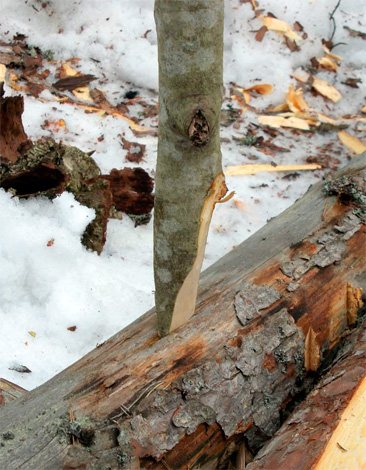
After the node flares up, the wedges can be pulled out, since the cavity for burning the fire will already be formed by burnt wood.
They ignite such a node, installing it obliquely (almost vertically). To do this, just lean its upper end on the trunk of another tree. The kindling is placed at the bottom of the gap. Due to the resulting air draft, the fire quickly spreads along the entire length of the crack and contributes to the rapid formation of coals between the two halves of the log.
After steadily burning coals appear, the node is placed on the ground and used as a heater. The wedges are removed from the node when the gap, due to the burnt wood, becomes thick enough to provide oxygen to the burning coals.
This version of the node is the only one that allows you to move it to a new place after lighting a fire. To do this, when such a need arises, the split log is taken from the side opposite to the burning and transferred to another place.
Also, if absolutely necessary, this option can be used with some caution on peat bogs, since there is almost no direct contact of fire with the soil.
The video shows step by step how to make and ignite such a node:
Nodya - night bivouac fire
Nodya - a type of bivouac tourist fire NODYA - a night bivouac tourist fire made of 2 or 3 logs lying on top of each other, used for heating when sleeping under a shelter, burns with an even, hot flame for several hours. The burning time directly depends on the thickness of the logs. Usually a node is constructed from 3 straight dry logs 35-40 cm thick. Pine is preferable - it burns with an even flame, without sparks; spruce and fir burn well, but they “shoot” embers that can burn through a sleeping bag or backpack.

Logs 1.5-2.5 m long, depending on the number of tourists spending the night by the fire, are cleared of branches and twigs. To make them flare up faster, they make numerous notches and notches on the side where the fire will be. The lower logs are placed tightly next to each other on the ground cleared of snow, at an acute angle to the direction of the wind. In the space between the logs, dry small brushwood, birch bark, tree moss are laid out along their entire length, and burning coals from another fire are laid out on them. When the brushwood burns, the third, thickest log is placed on top, first on small spacers - knots, small logs, so as not to “crush” the growing fire. The combustion will be uniform if the logs fit tightly together along the entire length; it is adjusted by turning the logs. You can light Nodya on an already burning fire. To do this, rake the fire to the length of the prepared logs, add brushwood, small logs and other kindling, and when they ignite, roll 2 bottoms onto the coals. logs so that the coals from the burning fire are mainly between them; then a third log is placed on top. See also “Bonfire”.
Prepared from materials: A short guide for tourists. 3rd ed. M., 1985; Lukoyanov P.I., Winter sports hikes. 2nd ed. M., 1988
Choosing logs for the node
The logs for logs are chosen to be dry: wet wood will burn poorly and is much more difficult to ignite, and it is very difficult to dry it due to the large thickness of the logs.
The logs must be straight, without rotten places. They should be cleared of knots, at least in those places where they will come into contact with each other. Otherwise, the node will burn unevenly and may go out, which can be fatal in a cold winter night.
The photo shows almost ideal logs for a node, ready for kindling:

Usually the length of the logs for the nodya is chosen according to the span of the two arms of the person who is going to sleep near this fire. The arm span approximately corresponds to the height of a person, which means there is no need to lie down next to the trunk to measure out the next piece for cutting.
In order for the fire to burn for a long time, you should try to make the logs for the node the same length. In a log made from logs that differ in length, part of the log does not burn and can cause uneven combustion, which reduces the effectiveness of the fire as a heater.
A place for a node and a bivouac with it
Both in the spring-autumn and in the winter, sufficient attention must be paid to preparing the site for the node. It may seem that making a node is simple, but this is to some extent a myth. In reality, for the purposes for which it is used, the node must be combined with a very well-constructed shelter that will accumulate heat, protect from precipitation and wind, and will not catch fire on its own. It is difficult to make such a shelter, and therefore a full night’s stay in the taiga with a node requires a long preparation of the camp.
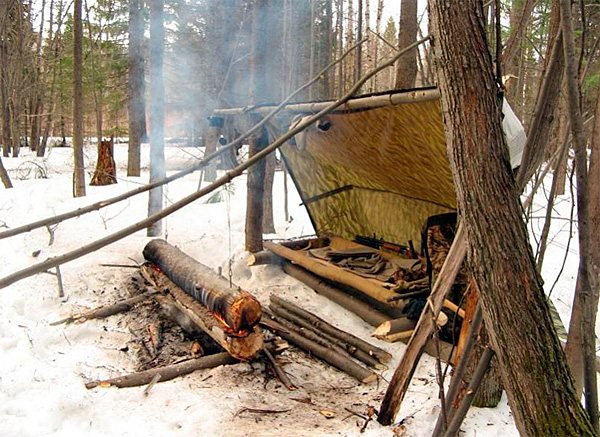
The entire structure of the bivouac must provide not only warmth for people, but also safety - the fire should not be extinguished by snow, the canopy and supports should not fall into it.
In winter, the place for the node must be cleared of snow, since a fire that burns for a long time can melt the snow and go deep into the snowdrift, ceasing to warm the person lying next to it.
In deep snow, a good option is a deck of two two-meter poles laid under the fire perpendicular to it. Due to the area of contact with the snow and the distance from the combustion source, the poles will remain on the surface of the snow cover and will not allow the fire to “drown” in the snow.
To prevent the log from rolling on the poles, a transverse indentation is made on one side with an ax. With this recess, the log is placed on one pole, and a part of the log without the recess is placed on the second.
With the proper organization of a bed and a bed, a person can spend the night in the forest even in very severe frosts. A well-prepared node does not require attention for a long time and provides enough heat throughout the night to warm the person lying opposite it at -20°C - -30°C and prevent him from freezing.
The photo below shows a bivouac with a node, in which a person can spend the night at almost any air temperature without risking his life:
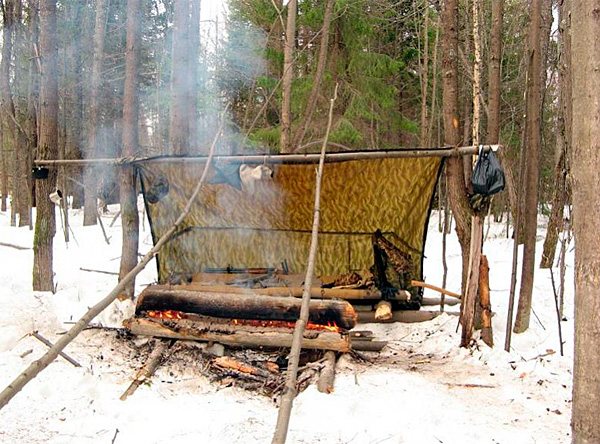
If a person sleeps alone, the bed is located parallel to the nodier; if two people are planning to spend the night, then both beds are located parallel to the fire on opposite sides of it. Only when positioned parallel to the fire will the body be sufficiently warmed by the heat of the fire.
When one person is resting on the side opposite the fire, you can make a screen that reflects heat. To do this, two pairs of stakes are driven into the ground, between which thin logs are laid one on top of the other, forming a kind of fence equal in width to the length of the fire. The top of such a screen can be insulated with spruce branches. However, in practice, many do without such a screen.
The fire and the bench are installed at a slight angle to the direction of the wind. With this arrangement, the fire is fanned by air currents, and the smoke does not fly towards the resting person.
It is recommended to make the bed on logs, laid in several floors and covered with heat-insulating material, for example, a carpet mat. In this case, the person sits opposite the fire and receives maximum heat from it. In addition, moving away from the cold ground reduces heat loss. Also, such a bed protects a sleeping person from a log rolling towards him. Although, of course, other simpler options for beds are also possible.

A canopy made of synthetic fabric can be replaced with a barrier made of poles and spruce branches, but making it is quite labor-intensive.
A canopy is installed over the bench, which protects the vacationer from precipitation and serves as a kind of screen that reflects the infrared radiation of the fire and thus increases its efficiency. If there is a chance of precipitation, you should also make a canopy over the fire.
Security measures
Like any other type of fire, nodya requires compliance with a number of fire safety rules.
So in spring, summer and autumn, when there is a possibility of forest fires, dry grass, leaves, spruce needles and other flammable materials are removed from the node to a safe distance.
You can dig a small ditch around the fire or pour sand, which will prevent the fire from spreading to the surrounding vegetation.
It is very undesirable to burn a node under dry tree branches and near dry reeds. Despite the small flame of the node, this is still an additional risk, most often associated with the inability to monitor the fire while sleeping.
You should also avoid organizing nodes on peat bogs, including in the cold season. In this case, a three-log node is definitely unacceptable, as it is more likely to lead to peat and related forest fires.
The use of spruce logs for nodes is also excluded, since spruce wood often shoots sparks during combustion. In winter, such a spark can ruin clothes or a sleeping bag, burn a person relaxing near a fire, and in the warm season can cause a forest fire. In the taiga, to select logs for a node, you need to look for windbreaks in deciduous areas and use the trunks of fallen trees for a fire.
If a high bed is not planned, then several pegs should be driven in between the node and the place to sleep or a thin stick should be placed. It will protect a sleeping person from a burning log accidentally rolling down. However, if the protective log is thick, it will become an impenetrable shield for thermal radiation, which will negatively affect the heating of a sleeping person.

It is precisely due to the fact that in a two-log node the flame is completely open, it is a more preferable option for spending the night.
We conclude: Nodya is good for long-term winter overnight stays, either alone or in a group of no more than two people, in a forest with suitable trees if you have a tool for harvesting thick logs. This fire is quite labor-intensive to organize, but once it ignites, it requires a minimum of effort and attention to maintain it and allows a person to sleep well in the warmth of it, without waking up to add firewood.
Author: Maxim Chechetov
Taiga fire that burns for a long time in the forest
Spending the night in the forest in winter conditions in frosty weather or in the cold autumn in the open air requires appropriate heating. A comfortable stay in a frosty forest or on the shore of a pond is the first condition for survival. For extreme conditions, the best fire is considered to be Nodya. It is the most economical, produces uniform combustion, does not require constant supervision and is not prone to premature extinction.

Products for inventors. Sale up to 50%

